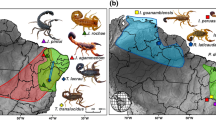Abstract
Three Lorisidae species (12 specimens in all) were studied cytologically: Arctocebus calabarensis, Nycticebus coucang and Perodicticus potto. Descriptions are given of the karyotypes found in these species and idiograms are presented. These data are compared with those previously reported while also the data available for the remaining two species of the family (Loris tardigradus and Nycticebus pygmaeus) are reviewed. Generally only minor differences exist between the results of this study and those of previous ones. One specimen of N. coucang however showed 52 chromosomes instead of the common diploid number of 50. In P. potto special attention was drawn to a marked system of chromosome associations.
Within the Lorisidae, the karyotypes of Perodicticus and Loris, both with the high diploid chromosome number of 62, are believed to be structurally close to the original karyotype in the family. Arctocebus (2n = 52) and Nycticebus (2n = 50,52) may have evolved from a common lineage, in which the original diploid number had been reduced to 52. This reduction may have taken place by the occurence of 10 centric fusion events.
Karyological relationships between the two Lorisoidea families, the Galagidae and the Lorisidae are discussed. A point of correspondence is the presence of karyotypes with 62 chromosomes in both groups, and probably they both evolved from a common ancestor with this diploid chromosome number. In view of the high fundamental numbers in all recent Lorisidae species, the early karyotypic evolution in this family must have been mainly influenced by mechanisms like pericentric inversion, translocations of small chromosome parts etc. In the Galagidae, on the other hand, the fundamental number, which must have been low in the original karyotype of the Lorisoidea, did not significantly increase in all except one species. In this family the karyotypic evolution was much more characterized by the occurrence of centric fusions. Thus, in spite of their common origin, fairly important differences exist between the present karyological characteristics of both families.
Similar content being viewed by others
References
Bender, M. A. & E. H. Y. Chu (1963). The chromosomes of primates. In: J. Buettner-Janusch (Ed.), Evolutionary and genetic biology of primates. Academic Press, London-New York.
Bender, M. A. & L. E. Mettler (1958). Chromosome studies in primates. Science 128: 186–190.
Boer, L. E. M.de (1972). Chromosome studies in some primates. Mamm. Chrom. Newsl. 13: 4–6.
Boer, L. E. M.de (1973a). Cytotaxonomy of the Lorisoidea (Primates: Prosimii). I. Chromosome studies and karyological relationships in the Galagidae. Genetica 44: 155–193.
Boer, L. E. M.de (1973b). Studies on the cytogenetics of Prosimians. J. hum. Evol. 2: 271–278.
Chu, E. H. Y. & M. A. Bender (1961). Chromosome cytology and evolution in Primates. Science 133: 1399–1405.
Chu, E. H. Y. & M. A. Bender (1962). Cytogenetics and evolution of primates. Ann. N. Y. Acad. Sci 102: 253–266.
Egozcue, J. (1969). Primates. In: K. Benirschke (Ed.), Comparative mammalian cytogenetics. Springer, Berlin-Heidelberg-New York.
Egozcue, J., R. N. Ushijima & M. Vilarasaude Egozcue (1966). The chromosomes of the slender loris (Loris tardigradus). Mamm. Chrom. Newsl. 22: 204.
Egozcue, J. & M. Vilarasaude Egozcue (1966a). The chromosomes of the slow loris (Nycticebus coucang). Mamm. Chrom. Newsl. 20: 50.
Egozcue, J. & M. Vilarasaude Egozcue (1966b). The chromosomes of the angwantibo (Arctocebus calabarensis). Mamm. Chrom. Newsl. 22: 53–54.
Egozcue, J. & M. Vilarasaude Egozcue (1966c). Simplified culture and chromosome preparations of primate leukocytes. Stain Technol. 41: 173–177.
Egozcue, J. & M. Vilarasaude Egozcue (1967). The chromosome complement of the slow loris (Nycticebus coucang Boddaert, 1785). Primates 7: 423–432.
Fiedler, W. (1956). Ubersicht über das System der Primaten. In: H. O. Hofer, A. Schultz & D. Starck (Eds.), Primatologia, Vol. I. Karger, Basel-New York.
Goodman, M. (1967). Effects of evolution on primate macromolecules. Primates 8: 1–22.
Hayata, I., S. Sonta, M. Itoh & N. Kondo (1971). Notes on the karyotypes of some prosimians, Lemur mongoz, Lemur catta, Nycticebus coucang and Galago crassicaudatus. Jap. J. Genet. 46: 61–64.
Hill, W. C. O. (1953). Primates I: 129–154. Interscience, New York.
Hill, W. C. O. (1972). Evolutionary biology of the primates. Academic Press, London-New York.
Klinger, H. P. (1963). The somatic chromosomes of some primates (Tupaia glis, Nycticebus coucang, Tarsius bancanus, Cercocebus aterrimus, Symphalangus syndactylus). Cytogenetics 2: 140–151.
Lewis, G. E. (1933). Preliminary notice of a new genus of lemuroid from the Siwaliks. Am. J. Sci. 26: 134–138.
Manfredi-Romanini, M. G., L. E. M.de Boer, B. Chiarelli & S. Tinozzi-Massari (1972). DNA nuclear content in the cytotaxonomy of Galago senegalensis and Galago crassicaudatus. J. hum. Evol. 1: 473–476.
Manna, G. K. & M. Talukdar (1968). An analysis of somatic chromosomes of both sexes of two primates, the slender loris, Loris tardigradus, and rhesus monkey, Macaca mulatta. Mammalia 32: 118–130.
Rao, S. R. V. & C. Seshadri (1968). Male meiosis in slender loris, Loris tardigradus lydekkerianus (Cabrera). Mamm. Chrom. Newsi. 9: 86.
Simpson, G. G. (1967). The tertiary lorisiform primates of Africa. Bull. Mus. comp. Zool. Harv. 136: 39–61.
Tattersall, I. (1968). A mandible of Indraloris (Primates, Lorisidas) from the miocene of India. Postilla 123: 1–10.
Walker, A. C. (1969). True affinities of Propotto leakeyi. Nature, 223: 647–648.
Author information
Authors and Affiliations
Additional information
The present cytological studies in primates are supported financially by a grant of the Netherlands Organization for the Advancement of Pure Research (Z.W.O.)
Rights and permissions
About this article
Cite this article
de Boer, L.E.M. Cytotaxonomy of the Lorisoidea (Primates: Prosimii). Genetica 44, 330–367 (1973). https://doi.org/10.1007/BF00161312
Received:
Accepted:
Issue Date:
DOI: https://doi.org/10.1007/BF00161312




